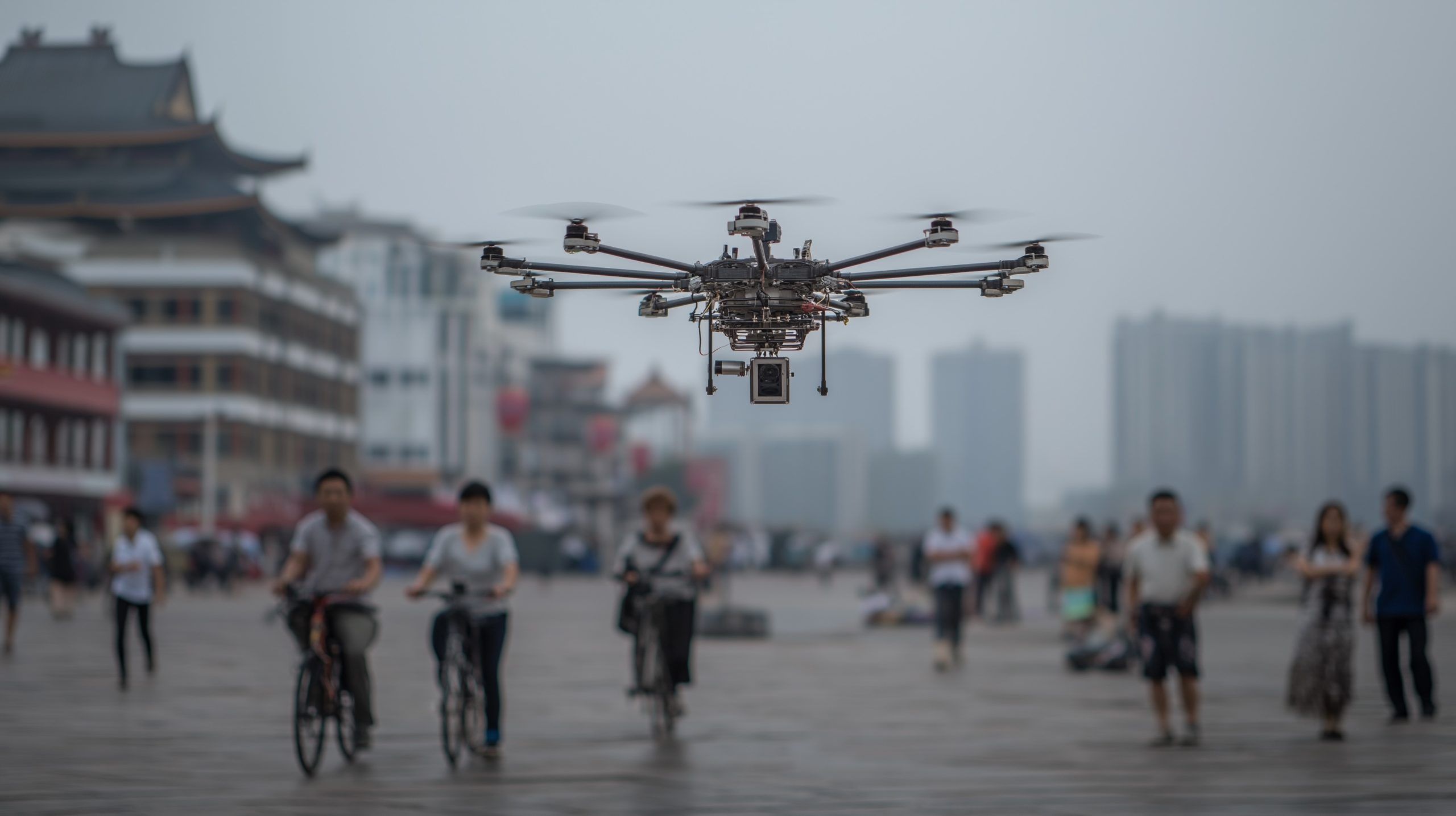- Starting January 1, 2024, all drones in China must be registered under the owner’s real name with the CAAC on shine.cn, and a QR code sticker is issued after registration.
- Foreign tourists must register their drones before flying, with registration tied to a Chinese phone number, and an English portal was reportedly launched in 2025.
- Recreational pilots of small drones do not need a formal license, but drones over 7 kg require a CAAC drone pilot license and drones over 116 kg require a full pilot’s license.
- The 120 m altitude limit applies nationwide, with airspace above it classified as controlled and requiring prior authorization, and drones must stay within visual line of sight.
- No-fly zones cover airports and urban areas, with a 10 km airport exclusion radius, and pilots should check the CAAC UOM map or DJI geofencing for suitable flight zones.
- Penalties include fines up to 50,000 yuan per individual and up to 200,000 yuan for companies; drones can be confiscated, licenses suspended, and criminal charges possible for endangering public safety.
- Commercial drone operations require a CAAC license and permit, and the operator must be a registered Chinese company with a Chinese citizen as the legal representative; foreign individuals cannot obtain a commercial license directly.
- Export controls tightened on September 1, 2024 restrict export of high-spec drones and components such as long-range systems (>50 km), high-end inertial sensors, engines (>16 kW), and drone swarm controllers.
- Foreigners are effectively limited to recreational flights; many cities impose additional local flight registrations with public security bureaus, with no exemption for paid work.
- Enforcement has become more aggressive, including the 2023 Shanghai case where drone hackers were jailed for geofence circumvention, and authorities use radar and jammers to shut down unauthorized drones near airports.
China has rapidly expanded its drone industry – but flying a drone there comes with a maze of regulations. Recent rule changes mean tougher requirements for registration, licensing, and flight permissions. This report breaks down what hobbyists, businesses, and foreign travelers must know about China’s drone laws in 2025, including new updates, enforcement crackdowns, and how they stack up against US, EU, and Japanese standards.
Regulations for Hobbyist Drone Pilots in China
Drone Registration: All drones in China must be registered under the owner’s real name. Since January 1, 2024, every drone – regardless of weight – requires real-name registration with the Civil Aviation Administration of China (CAAC) on its online platform [1]. (Previously, only drones over 250 g had to be registered, leading many to favor sub-250 g models like the DJI Mini to skip red tape [2]. But under the new rules, even those mini drones need registration.) To register, pilots must provide personal ID (passport for foreigners or national ID for locals), contact info, and drone details (model and serial number) [3]. After registering, you receive a QR code sticker that must be attached to the drone for identification [4] [5]. Practical tip: The CAAC’s website and app are in Chinese and require a Chinese mobile number for the SMS verification [6]. Foreign tourists often need to wait until arrival to register (using a local SIM or help from a Chinese friend) [7] [8]. An English-language registration portal was reportedly introduced in 2025, but if that fails, be prepared to navigate the Chinese site with assistance [9].
No Pilot License for Recreational Use: Hobbyist drone pilots do not need a formal license for small drones. China’s licensing rules kick in for heavier drones and advanced operations – for example, any drone over 7 kg requires a CAAC drone pilot license, and above 116 kg requires a full pilot’s license [10]. The vast majority of consumer drones (e.g. DJI Mavic series) weigh far less, so casual flyers don’t need to be certified. However, training is encouraged. The new 2024 regulations specify that drone operators “should have certain qualifications” [11], and basic safety knowledge is expected of all pilots.
Altitude & Distance Limits: China imposes a hard ceiling of 120 m (≈400 ft) above ground level for drones [12]. Under the latest rules, any airspace above “true altitude” 120 m is classified as controlled airspace [13]. In practice, this means if your drone climbs higher than 120 m from its takeoff point, you’re breaking the law. Even in the countryside or “open” areas, the 120 m cap applies unless special authorization is obtained. Staying below this limit is enforced by most DJI drones’ software and now by law [14]. Additionally, you must keep your drone within Visual Line of Sight (VLOS) at all times [15]. Beyond-line-of-sight flying or using FPV goggles without a spotter is prohibited for hobbyists (and only allowed in very limited trials for advanced operators) [16] [17]. Night flying is also restricted – you would need proper lighting and likely advance permission (similar to international norms).
No-Fly Zones: China has extensive no-fly zones (NFZs) covering airports, urban centers, and sensitive regions. For example, major cities like Beijing ban private drones over the downtown city area entirely without approval [18]. A minimum 10 km radius around airports is a strict no-fly area (a larger buffer than the 5 km used in many Western countries) [19]. Military bases, government compounds, border areas, and regions like Tibet and Xinjiang often have blanket bans or special clearance requirements [20] [21]. Even some tourist sites are off-limits despite no official airspace restriction – it’s common to see “No Drones” signs at famous attractions, and local security may enforce ad-hoc bans [22] [23]. DJI’s geofencing is programmed to prevent takeoff in many Chinese NFZs. The 2024 rules introduced a new concept of “suitable flight zones” (marked in green on the CAAC’s UOM map) versus controlled airspace. In general, only scattered green zones remain open for casual drone flight, and many previously flyable areas have been reclassified as controlled (requiring permission) [24] [25]. Always check the CAAC’s UOM app map or your DJI app before flying – if your location isn’t in a green zone, you likely need to apply for flight authorization or avoid flying there [26] [27]. Keep well away from crowds, political events, or protest gatherings – authorities are extremely sensitive about drones in such situations [28].
Other Rules: Drones should not drop objects or carry hazardous materials. It’s illegal to fly over people or densely populated areas without permission (China strictly polices drones over public events or city streets for safety). Respect privacy – using a drone to film someone without consent can violate China’s privacy and data laws, on top of aviation rules. Insurance is officially required: Chinese regulations mandate that drone operators have third-party liability insurance to cover any damage on the ground [29]. In practice, this rule is enforced mainly for commercial or larger drone operations, but hobbyists are strongly urged to carry insurance as well [30] [31]. Lastly, do not modify or hack your drone’s software to bypass limits – this is a criminal offense (as shown by recent cases of individuals jailed for removing no-fly limits; more on that under Penalties).
Commercial Drone Use: Business and Professional Operations
Operating a drone for commercial purposes in China is considerably more complex than flying for fun. All commercial drone flights require a CAAC license and permit, and only Chinese legal entities can obtain these authorizations [32] [33]. Key requirements include:
- Company Registration in China: The operator must be a registered business in China (e.g. a local company or a foreign-owned enterprise registered in China) and the company’s legal representative must be a Chinese citizen [34] [35]. In other words, a foreign individual cannot personally get a commercial drone license; you’d need to partner with or set up a Chinese company.
- Licensed Drone Pilot: The person flying the drone commercially must hold a UAV pilot license issued by CAAC appropriate to the drone’s weight category and operation type [36] [37]. Generally, any drone over 7 kg or any higher-risk operation (like aerial surveying, deliveries, crop spraying, etc.) triggers the licensing requirement [38]. Obtaining this license involves formal training and passing an exam administered by CAAC-approved instructors.
- Registered Aircraft & Insurance: The drone itself must be individually registered to the company in the CAAC’s system before it can be used commercially [39]. Proof of liability insurance covering drone operations is also mandatory [40] [41]. Companies typically need robust insurance given higher risks with commercial flights.
- Flight Permits and Airspace Approval: Beyond the license, each commercial operation may require flight authorization from aviation authorities or local Public Security bureaus, especially if in controlled airspace (which includes most cities). For example, to fly in a city like Shanghai for a shoot, the company must apply via the UOM platform or relevant local system in advance, detailing when/where the flight will occur [42] [43]. Some regions have online portals for permit applications (Zhejiang, Shanghai, Shenzhen have been cited as supporting online requests) [44] [45]. Usually, requests must be filed at least a day or more before the flight (the national rule is by 12pm the day prior for controlled airspace) [46]. Without an approved flight plan, any commercial drone flight in non-“green zone” airspace is illegal.
- Operational Limits: Commercial drones are generally subject to the same basic limits as hobby drones (120 m altitude, VLOS, no fly zones) unless specific exemptions are granted in the permit. For instance, a licensed operator with an approved plan might be allowed to fly higher or at night for a special project, but only with explicit clearance. Heavier drones (over 116 kg) are exceedingly rare in commercial use, but note they would be regulated almost like manned aircraft (full pilot license, etc.) [47].
In addition, drone delivery services or BVLOS (Beyond Visual Line of Sight) operations are only permitted in pilot programs approved by the government. China has been testing drone deliveries in limited trials, but any routine autonomous or BVLOS commercial flying is tightly controlled and not open to general businesses [48] [49]. Commercial operators also must comply with China’s data and privacy laws – for example, mapping or surveying might require extra clearance if it involves sensitive geographic data.
For foreign companies or professionals, doing drone work in China is cumbersome. Unless you establish a Chinese business and navigate the licensing process, you’ll need to hire local licensed drone service providers. The regulations introduced in 2018 and reinforced in 2024 make it effectively prohibitive for foreign companies to independently conduct aerial filming or inspections [50] [51]. Many international film crews, for example, partner with Chinese drone operators to handle the aerial shots legally.
Rules for Foreign Drone Operators and Tourists
Foreigners can bring and fly drones in China, but they must follow the same regulations as Chinese nationals – with a few extra hoops to jump through:
- Registration Requirements: There is no special exemption for foreign tourists – if your drone is over 0.25 kg (which includes virtually all camera drones), you must register it with the CAAC before flying [52] [53]. As noted earlier, the online registration system is in Chinese and tied to Chinese phone numbers, making pre-trip registration difficult. Tourists often end up registering after arrival by getting a local SIM card or asking a Chinese friend or service to assist [54] [55]. Failing to register means you’re technically flying illegally, and since registration is tied to enforcement (police can use a drone’s serial/QR code to find the owner), it’s a crucial step. (One workaround some travelers used in the past was flying a sub-250 g drone to avoid registration – but as of 2024, that loophole is closed under the new rules requiring all drones to register [56].)
- Recreational Flying Only: Foreigners are effectively limited to recreational flying. Chinese law does not explicitly ban foreigners from piloting drones, but only Chinese entities can obtain commercial drone permits [57]. This means a tourist or foreign freelancer cannot legally perform paid drone work or large-scale mapping on their own. If you’re a foreign photographer or vlogger, you should keep your drone use personal/non-commercial to stay within the law. (Any attempt to do commercial projects would require partnering with a local licensed company.)
- Flight Approvals and Local Rules: As a visitor, you need to be even more cautious about where you fly. Many Chinese cities have additional local registration or notification rules for drone flights. For example, Shanghai requires drone users (even hobbyists) to register each flight with the public security bureau via a local app in addition to the CAAC registration [58] [59]. These local requirements might be in Chinese and not obvious to foreigners. It’s wise to ask local drone hobbyist groups or forums for guidance in each city. Moreover, foreigners flying drones can attract attention – expect bystanders or security to approach you if you fly in an area they find sensitive. There are reports of locals telling foreign drone pilots to stop, even if the area isn’t explicitly prohibited, due to a general wariness of drones and foreigners [60]. To avoid issues, it’s best to fly discreetly in open areas, away from crowds or official buildings, and consider flying with a local buddy who knows the ropes [61].
- Documentation: Always carry your passport, drone registration proof (the QR code sticker or printout), and any flight permission documentation you have. If police approach, you’ll need to show these. Police and military in China have broad authority – if they aren’t satisfied, they may ground your flight or even confiscate the drone first and ask questions later. Having the registration and explaining your purpose (e.g. “just taking scenic photos as a tourist”) in a polite manner can go a long way. Note that in some politically sensitive areas (Tibet, Xinjiang), a foreigner with a drone may be viewed with suspicion regardless, so weigh carefully if you really need to fly in those regions.
Bringing Drones Through Customs: Tourists generally have no problem bringing a personal drone into China. There is no import ban on consumer drones for personal use, and customs usually does not ask for any special documentation. In fact, Chinese airport customs typically will not check your drone’s registration status or stop you just for carrying a drone [62]. Thousands of travelers enter China with DJI drones in their luggage every year without incident. You do not need to declare a personal drone as long as it’s clearly for your own use (not a bulk import). However, you should pack it properly: airlines require drone batteries to be in carry-on luggage, not in checked bags, due to safety regulations [63]. Make sure to hand-carry your LiPo batteries (usually in a fire-safe bag) and either carry on the drone or securely pack it without batteries if you must check it. Also, be mindful of China’s rules during special events – occasionally, during political meetings or holidays, authorities temporarily ban drones in certain cities and might increase screenings. But under normal circumstances, bringing a drone in or out of China for a trip is hassle-free. When leaving China with your drone, similarly, there are no exit formalities as long as it’s your same drone; just pack batteries in carry-on again.
Drone Imports and Exports: Customs and Trade Rules
For personal travel, as noted, importing or exporting your drone with you is straightforward – treat it like a camera. But on a larger scale, China has recently tightened controls on the trade of drones and drone technology:
- Importing Drones to China: China is the world’s largest producer of drones (home of DJI and others), so most people aren’t importing drones into China. If you did ship or bring a high-end drone into the country (for example, a custom-built or non-Chinese drone for a project), you might owe import duties if it’s new and above duty-free allowances. However, there are no special prohibitions on drone hardware. Just ensure any wireless equipment meets Chinese frequency standards (most consumer drones do). In general, Chinese law treats drones similar to other electronics for customs purposes – one unit for personal use is fine, but bringing many units could be seen as a commercial import requiring declaration.
- Exporting Drones from China: In 2023-2024, China imposed export restrictions on certain drones and drone components due to geopolitical and security concerns. Effective September 1, 2024, the government expanded controls on drones that might have military uses [64]. Chinese companies now need special licenses to export high-spec drones, such as those with long-range communications (>50 km), high-end inertial sensors, powerful engines (>16 kW), or the ability to control swarms of drones [65] [66]. Anti-drone jamming equipment above certain capabilities is also restricted [67]. These measures were taken to prevent Chinese drone tech from enhancing foreign militaries or being used in conflicts. For the average consumer drone (like DJI Phantom, Mavic, etc.), these restrictions typically do not apply unless the model has advanced features exceeding the specified thresholds. DJI, for instance, has halted direct sales of some models to regions like conflict zones to comply with these rules.
- Practical impact: If you’re a traveler who bought a drone in China to take home, you will almost certainly be fine – personal ownership export isn’t targeted. But if you tried to ship multiple drones or a large professional drone out of China, it might get flagged by customs if it falls under the controlled categories. Always check the latest export control list if you plan to send drone hardware abroad from China. These rules have also affected foreign buyers; e.g., companies in the U.S. or Europe sourcing drones from China might face delays or need permits for high-end units [68].
- Temporary Import/Export (Carnet): For film crews or commercial operators bringing specialized drones into China for a project and back out after, it’s wise to use an ATA Carnet (an international customs document) or get written import/export clearance to avoid hassles. China is a participant in the carnet system, which can simplify the temporary import of professional equipment.
In summary, personal drone gear for travel isn’t restricted by Chinese customs in any unusual way – just follow normal battery safety rules. But on a policy level, China is carefully managing how advanced drone technology flows across its borders.
Recent Regulatory Updates (2024–2025)
The past two years have seen major shifts in China’s drone regulation landscape, as authorities respond to booming drone usage and security incidents:
- Interim UAV Regulations – Effective Jan 1, 2024: The biggest change was the implementation of the Interim Regulations on the Management of Unmanned Aircraft Flights, a comprehensive policy issued by the State Council and Central Military Commission [69]. This went into effect on January 1, 2024 and introduced a unified framework for drone design, production, and flight operations. For everyday users, the immediate impacts were:
- Mandatory real-name registration for all drones (closing the sub-250 g exemption) [70].
- Strict 120 m altitude limit nationwide – codifying that anything above 120 m is controlled airspace requiring prior ATC approval [71].
- Defined airspace categories: The regulations clearly delineated “suitable flight zones” (where drones can fly without prior application) vs “controlled airspace” and outright prohibited zones [72] [73]. This clarity was new; previously, hobbyists relied on DJI’s maps or scattered notices. Now it’s formally in the rules that outside of designated open areas, you must file a flight plan in advance (generally 36 hours before) for approval [74].
- Pilot qualification and oversight: The rules emphasize that operators need proper qualifications (which for hobbyists means following the rules; for larger drone pilots means licensing) [75]. They also beef up enforcement mechanisms like tracking registered drones and enhancing “supervision systems” to respond to incidents [76] [77].
- Export Control Measures (2023–2024): In response to global geopolitical tensions, China started placing export curbs on drones. In 2023, initial restrictions were announced on certain high-performance drones. Then on July 31, 2024, China expanded those export controls, further limiting sales of drones and drone parts that could have military uses [82]. Components like advanced imaging systems, long-range communication modules, powerful engines, and drone swarm controllers fell under these new restrictions [83] [84]. The timing corresponded with reports of Chinese-made drones being used in conflicts abroad, so China moved to show it’s regulating such exports. For the domestic scene, this doesn’t change how you fly a drone, but it’s a notable policy shift that shows China’s intent to control high-end drone tech. Manufacturers in China now have to get government permission to export those sensitive items, effective September 2024 [85] [86].
- Enforcement Trends: Chinese authorities have become more aggressive in enforcing drone rules. In 2023 and 2024, several incidents made headlines:
- Police in various cities have cracked down on individuals flying in forbidden zones (e.g. tourists flying drones near Beijing’s Forbidden City have been detained in the past) [87]. During events like large trade expos or political meetings, cities like Beijing and Shanghai explicitly ban all private drones – violators during these times are swiftly intercepted.
- A high-profile case in April 2023 saw two men in Shanghai prosecuted for hacking drone software to disable geo-fencing and height limits. They had unlocked over 100 drones (charging others for the mod service) before getting caught. The court sentenced them to 7 months and 5 months in prison, plus fines for illegally extending drones’ flight range into restricted areas [88] [89]. This was the first case of jailing drone “geofence hackers” in China, signaling a zero-tolerance approach to tampering with safety features.
- Continued reports of drones disrupting civil aviation have led to harsh outcomes. In one oft-cited 2017 incident, a rogue drone near Chengdu Shuangliu Airport caused 22 flights to divert [90]. The authorities have since made clear that endangering flight safety (e.g. flying near airports or flight paths) can be prosecuted under criminal law for endangering public security. By 2025, CAAC and police units are using tech like radar and drone jammers to promptly shut down unauthorized drones near airports or sensitive sites. In short, enforcement is both high-tech and heavy-handed.
Overall, 2024 was a turning point that moved China’s drone rules closer to a formalized, stringent system akin to manned aviation. Hobbyist freedoms were curtailed (e.g. casual high-altitude shots are essentially a thing of the past), while the government ramped up monitoring. Drone users in China in 2025 must be diligent in staying within the rules, as the grace period of “lax enforcement” is clearly over.
Enforcement and Penalties in China
China backs up its drone regulations with steep penalties – both financial and legal – to deter improper use [91] [92]. Here’s what can happen if you break the rules:
- Fines: The CAAC can levy fines on individuals from ¥1,000 up to ¥50,000 per violation (roughly $140–$7,000), depending on severity [93]. Companies face even higher fines, up to ¥200,000 (≈$28,000) for an offense [94]. For example, flying an unregistered drone or without the required license can incur fines up to around ¥10,000 for a person [95]. Operating in a restricted zone without permission can be fined up to ¥20,000 for an individual [96]. These are significant sums, meant to emphasize compliance.
- Confiscation and Suspension: Authorities will typically confiscate your drone if you’re caught in a serious violation (e.g. flying in a no-fly zone, near an airport, or using an unregistered drone) [97] [98]. They can also suspend or revoke any drone pilot licenses or permits you hold [99]. It’s not unusual for police to simply take the drone on the spot if you’re in the wrong place and sort out the paperwork later.
- Criminal Charges: If your drone activity endangers public safety or national security, China will not hesitate to pursue criminal charges [100]. This could happen if, say, you fly in airspace that disrupts commercial flights, or if you film sensitive military installations. Criminal penalties can include imprisonment in addition to fines. Notably, under China’s Criminal Law, acts that threaten flight safety or breach national security can lead to multi-year prison sentences. In practice, there have been instances: those who flew drones over restricted military areas have been detained, and as mentioned, two drone hackers in 2023 got several months of jail time for enabling illegal flights [101] [102]. A foreign national was reportedly detained for flying a drone in central Beijing where it was forbidden [103]. And causing an aviation incident (like the Chengdu airport case) could land a pilot in serious legal jeopardy – potentially facing charges of endangering public security, which carry hefty prison terms.
- Examples of Penalties: To illustrate, the Shanghai drone hackers not only went to jail but were fined ¥3,000 and ¥2,000 each as well [104] [105]. In another case, media noted that flying a drone during a prohibited time in a Chinese city led to the operator’s arrest and equipment seizure on the spot. While minor infractions (first-time hobbyists caught in a park without registration) might result in a warning or modest fine, Chinese authorities are increasingly inclined to make examples of people. They want to send a message that drones are not a toy to be flown recklessly.
- Enforcement Methods: China employs technology and community reporting to enforce the rules. The CAAC conducts random inspections and can audit drone flight logs or registration records [106] [107]. DJI’s AeroScope receivers (which track drone signals) are used by police in some cities to locate rogue drones in real time. If a drone is registered, law enforcement can trace its owner immediately via the registration database – and they have used this info to pay visits to pilots who violated rules [108] [109]. There are even instances of police using jamming rifles or interceptor drones to force down drones that stray into restricted airspace. All of this is backed by a legal framework that permits the government to neutralize threats (so don’t be surprised if your drone inexplicably auto-lands – it might have been forced down by geofencing or an external command).
In summary, ignorance is no excuse. Penalties in China can be as tough or tougher than those in Western countries. The government treats unauthorized drone flights as a serious public safety issue, not a minor infraction. Anyone planning to fly in China should take these enforcement realities to heart – follow the rules to the letter, or you risk steep consequences.
How China’s Drone Laws Compare Internationally
China’s drone regulations in 2025 are among the strictest in the world in certain aspects, though they share many common points with US and European rules. A brief comparison:
- United States: The US also requires drone registration (with the FAA) for any drone over 250 g, similar to China’s historical threshold [110]. However, in the US a foreign visitor cannot register a drone (registration is limited to US citizens/residents) – a quirk that effectively encourages tourists to use sub-250 g drones in America. China’s registration now applies to all drones regardless of weight, making it more encompassing. For hobbyists, the US has a 400 ft (~120 m) altitude limit just like China [111], and a VLOS rule. But where China outright bans drones in central Beijing or other cities, the US approach is more zone-based – e.g. Washington D.C. is a “No Drone Zone” by federal law, and around airports there’s typically a 5 mile (≈8 km) restriction unless clearance is given [112] [113]. China’s 10 km airport exclusion is slightly larger [114]. Both countries restrict flights over people without special waivers. The US requires hobbyists to pass a simple knowledge test (“TRUST”) which China does not have (China relies on registration and, informally, the assumption you’ll learn the rules). For commercial operations, the US Part 107 remote pilot license is arguably easier to obtain than China’s commercial licensing, and it’s available to foreigners (they just need to pass the test in the US). The US also introduced Remote ID broadcast requirements in 2023 for drones, whereas China so far has not mandated a Remote ID transmitter for civilian drones (registration and geo-fencing have been its focus). Enforcement in the US can involve hefty fines (up to $27,500 civil, $250,000 criminal in extreme cases) and occasional prosecutions, but jail is very rare for drone offenses in the US [115] [116]. In China, jail time – while not the norm – is more readily used when security is a concern (as seen with the hackers case).
- European Union: The EU, through EASA, has a unified framework that also uses risk-based categories. In many ways, EU rules are less restrictive for hobbyists compared to China’s new regime. In the EU, drones are classified in the Open category (low risk) if under certain weight and kept within visual line of sight. As long as you avoid crowds and stay below 120 m AGL, hobbyists can fly without individual permission in most places (outside restricted zones) [117] [118]. Europe does require registration of operators for drones over 250 g or any drone with a camera (which covers essentially all camera drones), and a small online exam for hobbyists in the Open category. Once registered in one EU country, a foreign operator can fly in others under the same rules – a contrast to China’s requirement of a local phone and local app. Europe also mandates Remote ID for new drone models from 2024, something China hasn’t implemented yet. When it comes to no-fly zones, Europe leaves a lot to national authorities: e.g. Paris bans drone flights over the city without special permission (somewhat analogous to Beijing), and London has strict airport zones [119]. But generally, Europeans have more “green zones” to fly than what China now designates – China’s suitable zones have become quite limited near cities [120]. On enforcement, European penalties range by country but usually involve fines in the low thousands of euros for routine violations, scaling up for dangerous acts. Imprisonment is possible but uncommon except for egregious cases (like endangering an aircraft). One can say China’s enforcement is more centralized and uncompromising, whereas Europe’s is a patchwork but moving toward uniformity.
- Japan: Japan’s drone laws share some similarities with China’s in strictness. Japan requires registration of all drones over 100 g, and since 2022 has required remote ID broadcasts from drones in flight. Like China, Japan bans drones over densely populated areas and sensitive sites without permission – you cannot fly in central Tokyo at all, for instance, without a hard-to-get exemption. Altitude is limited to 150 m in Japan for normal operations, slightly higher than China’s 120 m, but essentially in the same range. Both countries require line-of-sight and restrict night flying unless specially allowed [121] [122]. One big difference: Japan introduced a formal pilot license system in 2022 for larger drones and advanced flights, with strict exams and even medical checks for the highest level. China’s licensing for heavy drones is also strict, but for hobby-level drones China doesn’t (yet) require an online test or license like Japan does for any drone over 100 g. When it comes to penalties, Japan has been hiking fines (flying in prohibited areas can cost up to ¥500,000 JPY, about $4,000) and can impose up to a year in jail for certain offenses [123] [124]. They even have “drone police” with net guns in Tokyo. In China, fines can be similar (¥50,000 CNY max for individuals, roughly ¥1,000,000 JPY) and jail is on the table too. Both nations take a very security-conscious view of drones due to past incidents (a drone once landed on the Japanese PM’s roof as a protest, prompting a crackdown [125]; China’s worries stem from airport incidents and general national security).
In summary, China’s drone laws have quickly evolved to mirror international norms on basics like altitude and registration, but they go further in some respects. China heavily restricts where you can fly (carving out only certain areas as freely flyable) and makes it bureaucratically difficult for foreigners or non-residents to operate drones. By contrast, the US and EU, while enforcing rules, generally allow more freedom in open areas without case-by-case permission. For anyone used to flying in the US/EU, China’s requirements might feel onerous – but they reflect the government’s stance that drones pose security risks that must be tightly managed. Always check the local rules of any country, but assume China’s are on the stricter end. If you comply with China’s regulations, you’ll likely be in good shape for most other countries’ rules (with the possible exception of unique local twists). And conversely, something allowed casually in the US or Europe (like a quick neighborhood flight) could be forbidden in China if that neighborhood falls in a “controlled” zone. International drone pilots should plan accordingly and, when in doubt, err on the side of not flying unless you’re sure it’s legal in China’s eyes.
Sources:
- Civil Aviation Administration of China – Official UAV Regulations and Registration Platform [126] [127]
- “Drone Registration in China” – Mercier Zeng (2025 update) [128] [129]
- “Flying Drone in China: 2025 Regulations” – TravelChinaCheaper [130] [131]
- “New Regulations Spark Questions from Drone Enthusiasts” – Shanghai Daily (Jan 2024) [132] [133]
- TS2 Tech “Drone Laws in Every Country 2025” – China section [134] [135]
- SCMP – “China imposes export controls on drones” (Jul 31, 2024) [136] [137]
- FlyEye “Chinese Drone Regulations – Penalties and Enforcement” (2024) [138] [139]
- Shanghai Daily – “Drone operators arrested for cracking drone systems” (Apr 2023) [140] [141]
- FAA & EASA drone guidelines for comparison [142] [143]
References
1. www.shine.cn, 2. ts2.tech, 3. drone-laws.com, 4. drone-laws.com, 5. www.travelchinacheaper.com, 6. www.travelchinacheaper.com, 7. www.travelchinacheaper.com, 8. www.travelchinacheaper.com, 9. www.travelchinacheaper.com, 10. drone-laws.com, 11. english.www.gov.cn, 12. drone-laws.com, 13. www.shine.cn, 14. drone-laws.com, 15. drone-laws.com, 16. ts2.tech, 17. ts2.tech, 18. ts2.tech, 19. ts2.tech, 20. drone-laws.com, 21. ts2.tech, 22. www.shine.cn, 23. www.shine.cn, 24. www.shine.cn, 25. www.shine.cn, 26. www.shine.cn, 27. www.shine.cn, 28. ts2.tech, 29. www.travelchinacheaper.com, 30. drone-laws.com, 31. www.travelchinacheaper.com, 32. drone-laws.com, 33. www.travelchinacheaper.com, 34. drone-laws.com, 35. www.travelchinacheaper.com, 36. drone-laws.com, 37. ts2.tech, 38. ts2.tech, 39. www.travelchinacheaper.com, 40. drone-laws.com, 41. www.travelchinacheaper.com, 42. www.shine.cn, 43. www.shine.cn, 44. www.shine.cn, 45. www.shine.cn, 46. www.shine.cn, 47. drone-laws.com, 48. ts2.tech, 49. ts2.tech, 50. www.travelchinacheaper.com, 51. www.travelchinacheaper.com, 52. ts2.tech, 53. www.mercierzeng.com, 54. www.mercierzeng.com, 55. www.travelchinacheaper.com, 56. www.shine.cn, 57. www.travelchinacheaper.com, 58. www.shine.cn, 59. www.shine.cn, 60. www.travelchinacheaper.com, 61. ts2.tech, 62. www.mercierzeng.com, 63. www.travelchinacheaper.com, 64. www.scmp.com, 65. www.scmp.com, 66. www.scmp.com, 67. www.scmp.com, 68. www.scmp.com, 69. english.www.gov.cn, 70. www.shine.cn, 71. www.shine.cn, 72. www.shine.cn, 73. www.shine.cn, 74. www.shine.cn, 75. english.www.gov.cn, 76. english.www.gov.cn, 77. english.www.gov.cn, 78. www.shine.cn, 79. www.shine.cn, 80. www.shine.cn, 81. www.shine.cn, 82. www.scmp.com, 83. www.scmp.com, 84. www.scmp.com, 85. www.scmp.com, 86. www.scmp.com, 87. ts2.tech, 88. www.shine.cn, 89. www.shine.cn, 90. www.shine.cn, 91. www.flyeye.io, 92. www.flyeye.io, 93. www.flyeye.io, 94. www.flyeye.io, 95. www.flyeye.io, 96. www.flyeye.io, 97. www.flyeye.io, 98. www.flyeye.io, 99. www.flyeye.io, 100. www.flyeye.io, 101. www.shine.cn, 102. www.shine.cn, 103. ts2.tech, 104. www.shine.cn, 105. www.shine.cn, 106. www.flyeye.io, 107. www.flyeye.io, 108. ts2.tech, 109. ts2.tech, 110. ts2.tech, 111. ts2.tech, 112. ts2.tech, 113. ts2.tech, 114. ts2.tech, 115. ts2.tech, 116. ts2.tech, 117. ts2.tech, 118. ts2.tech, 119. ts2.tech, 120. www.shine.cn, 121. ts2.tech, 122. ts2.tech, 123. ts2.tech, 124. ts2.tech, 125. ts2.tech, 126. drone-laws.com, 127. www.shine.cn, 128. www.mercierzeng.com, 129. www.mercierzeng.com, 130. www.travelchinacheaper.com, 131. www.travelchinacheaper.com, 132. www.shine.cn, 133. www.shine.cn, 134. ts2.tech, 135. ts2.tech, 136. www.scmp.com, 137. www.scmp.com, 138. www.flyeye.io, 139. www.flyeye.io, 140. www.shine.cn, 141. www.shine.cn, 142. ts2.tech, 143. ts2.tech










